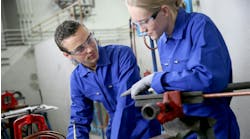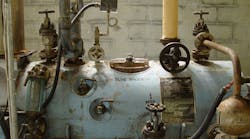Latest from Management
Sponsored
I recently received the below letter from one of my customers:
Hi Dave,
I know you get a lot of questions, so I hope you won't mind one from me...
My mother had her 50-year-old boiler replaced recently with a new Peerless WBV-03-W (runs on oil). It's really noisy when it runs. Her heating guy tells her it's because of the higher efficiency, but it worries her. She's an elderly lady who lives alone, so it's the kind of worry that just gnaws at her.
I told her that I know a guy who knows about home heating (!) and I would ask if it is simply a matter of it being a newer, more efficient unit.
As I'm sitting here, I noticed that it also cycles on and off continuously during the bitter cold weather. Bad sign! So I'm guessing (too late) that it wasn't properly sized. I'm hoping to get her an energy audit this spring and tighten up the house some (it's pretty leaky). Would that help? Short of getting a new boiler, is there anything we can do?
Thanks so much, Dave, for any advice you can offer. Mom says thanks, too!
Best, Deb
A kind response
Hi Deb,
Sorry to hear the new boiler is worrying your mom. Let’s see what can be done to put her concerns to rest. Air leakage in and/or out of homes typically accounts for 30% to 50% or more of the heat loss.
The Peerless WBV-03 is a cast iron sectional boiler. It can be fired at three different ratings, so it will be necessary to find out which oil nozzle was installed. All oil nozzles are rated in GPH (gallons per hour) based upon the pressure generated by the burner’s oil pump and the Peerless literature shows the WBV-03 with 0.6-, 0.85-, & 1.05-GPH nozzles. Your Mom's system is hot water (not steam), and Peerless indicates the net output ratings are 75,000, 104,000 and 126,000 Btuh. The 0.6-GPH firing rate requires the Riello F-3 burner.
I gather no heat loss calculation was performed by the contractor, which would reveal a best match for sizing. We are currently well below design conditions here (at 6°F this morning and expected to be -1°F Sunday night into Monday and design day conditions according to ASHRAE guidelines are 13°F for my area — your mom’s will be different, but we’ll get to that), and most installed equipment is still cycling on/off. Over-sizing HVAC equipment is a stronger urge than procreation!
If your mom's WBV-03 has the 1.05 GPH nozzle, the boiler should be able to be de-rated by installing one of the smaller nozzles, but I would want a blessing from Peerless first just in case that would require a new target-wall (refractory material to protect the cast iron from direct flame impingement) or any other modifications. Three different brands of burners are available and each has somewhat different operating characteristics.
Noise issues can be related to combustion adjustments, improperly adjusted draft regulator, and the change from older less efficient 1725-RPM to the high-efficiency 3450-RPM oil burner. Draft is adjusted to meet specifications at the combustion chamber and in the flue piping. You should see a small-diameter hole drilled in the flue piping between the boiler and draft regulator. Hopefully the installer utilized an electronic combustion analyzer to adjust the burner for achieving optimum operating efficiency. If so, they should have printed out the results and left them with the literature or provided your mom with a copy.
The oil burner will have primary and secondary air shutters that the installer adjusts to provide the proper mix of air-to-fuel with a wee bit of excess O2 that is measured using the combustion analyzer. Carbon monoxide and carbon dioxide are also measured. Combined with the net stack temperature of the exhaust, you can determine the actual operating efficiency. If they did perform this necessary step, then the noise may simply be inherent to that model burner.
One local supplier (Sid Harvey) indicates both the Carlin & Becket burners have insulated sound covers available to reduce noise. If the boiler came equipped with a Riello burner, it will already have a sound cover.
1. Check on the combustion analysis and if not done, can they do it and if not, hire someone to do that ASAP. Obtain the print-out for your Mom's records.
2. Possibly de-rate to a lower GPH nozzle (requires another combustion analysis if one was done previously). A Manual-J calculation should be performed to determine the home's heat loss.
3. Get the cone-of-silence (insulated sound cover) for the burner.
Make sure the installer registered the warranty. All too often we find the blank warranty card still attached to the literature in the packet left in the mechanical room.
All Dave Yates material in print and on Contractor's Website is protected by Copyright 2015. Any reuse of this material (print or electronic) must first have the expressed written permission of Dave Yates and Contractor magazine. Please contact via e-mail at: [email protected].
Dave Yates
Dave Yates material in print and on Contractor’s Website is protected by Copyright 2017. Any reuse of this material (print or electronic) must first have the expressed written permission of Dave Yates and Contractor magazine.


